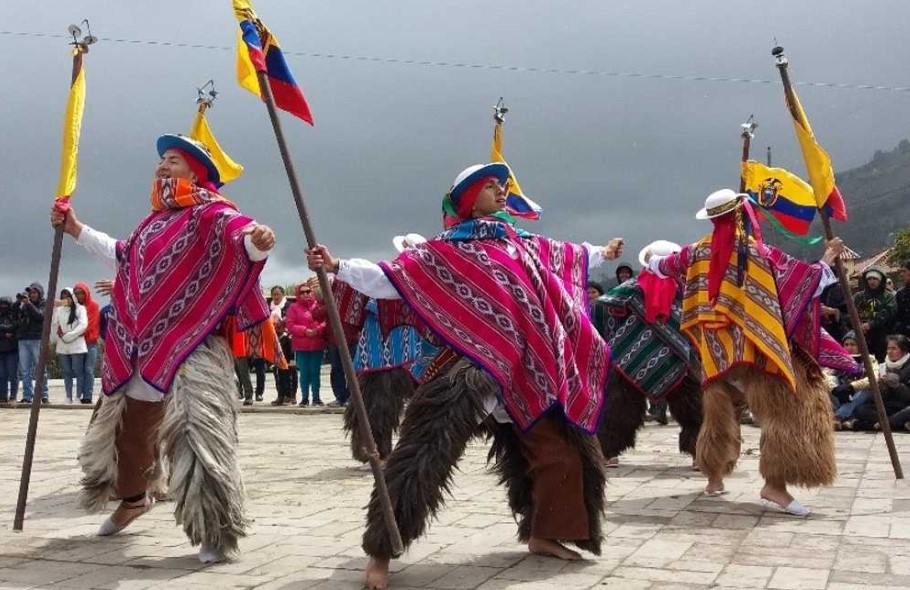Inti Raymi celebrations highlight Ecuador’s special relationship with the sun

Descendants of the Cañari civilization celebrate Inti Raymi at Ingapirca, north of Cuenca.
The name ‘Ecuador’ comes from the Spanish word for ‘equator’: the place where the sun is at its highest. This intense sunlight not only supports food crops but other sacred and endemic species. Unearth the country’s relationship with the sun and delight in how it shapes the country today.
By Sarah Gillespie
The Inca sun god was called Inti, from whose golden face a corona of flames extended. He was the most revered of all gods, providing warmth and light for crops to grow and for people to live. Today, the sun continues to play a pivotal part in Ecuadorian society. From festivals to fish, here are some of the ways the sun drives culture and crops in the present day.

Ecuadorian villagers give offerings and burn palo santo sticks to ward off evil spirits during Ecuador’s Festival of the Sun.
In modern times, villages across the Ecuadorian Andes pay tribute to Inti with the Festival of the Sun, or Inti Raymi. From Pichincha to Imbabura, during the festival in June, Indigenous villagers visit rivers and springs to take part in a ceremonial bathing ritual called Armay Chisi. This custom is said to wash away negative energies, renew their spirits and revive the individual’s connection to nature. The celebrations continue with dancers offering fruit and villagers consuming maize-based foods in gratitude for a bountiful harvest. The biggest of these festivals takes place in the town of Otavalo on 21 June, where visitors are eagerly welcomed by locals to join in with the festivities.
Connecting to nature
Along Ecuador’s coast grows the palo santo (‘holy wood’) tree, which reaches up to 60ft in height and lives for up to 200 years, thanks to the sun’s intensity. When the tree dies, the oils in the wood can be turned into a fragrant, citrus-like incense, which takes five to eight years to fully mature.
Once the oil has matured, the wood is cut into sticks for use in spiritual ceremonies, like the Festival of the Sun, while in Indigenous communities, it’s used for the practice of smudging — burning the sticks to ward off evil spirits. Spanish colonists, too, were beguiled by the scent, and began to use palo santo in Catholic rites. Today, visitors to Ecuador will encounter the scent of palo santo drifting along the streets of Quito and Baños from church doorways. You’ll also find it in bars, such as the Casa Gangotena hotel bar, where burning palo santo sticks are used as a cocktail garnish. Further towards the coast, the Hotel del Parque lights palo santo in the evenings to not only scare away bad energies but to also prevent mosquitoes.

The sun is celebrated in parades throughout Ecuador, like this one in Cuenca.
On Ecuador’s Galápagos Islands, forests of palo santo mingle with the unique species that so captivated Charles Darwin when he visited these lands. Cold-blooded marine iguanas bask on the shore, absorbing the sun’s energy before diving into the ocean to feed.
Connecting to wildlife
The sun’s effects are far more apparent in the chlorophyll-rich Ecuadorian Amazon — home to 2,296 known tree species, which in turn support countless smaller plants and animals.
At the base of the Galápagos’s marine food chain is a type of chlorophyll-rich algae called phytoplankton. Just like plants, phytoplankton photosynthesise sunlight to grow and live. They thrive in cooler water; the Galápagos have an abundance of phytoplankton, thanks to the Humboldt Current, which transports cool water from Antarctica up South America’s west coast.
Phytoplankton are eaten by zooplankton and fish, which are then eaten by larger predators. Travellers can enter the water with excursions such as Metropolitan Touring to see a whole range of the islands’ marine biodiversity: green turtles, manta rays, barracudas, hammerhead sharks. It’s a mark of the sun’s importance here, that the area’s communities owes much to solar-fuelled organisms the human eye cannot even see.
In recent years, the Indigenous Amazonian Achuar people have harnessed the sun for a novel purpose: to power their boats. Previously, they’d travelled in petrol-powered canoes, using fuel imported by plane at great expense. Building roads would help to cut costs but would damage the fragile forest ecosystem.

Thanks to the year-round sunlight in Ecuador, the country is one of the world’s largest suppliers of roses.
In 2016, Kara Solar, a non-profit formed by a collaboration between engineers and the Achuar, launched its first solar-powered boat in Achuar territory. There are now six boats in the fleet, which carry up to 20 passengers and serve nine communities. The Achuar use them to take children to school, transport wares to the market and to spot illegal loggers.
Travellers wishing to experience the environmentally conscious culture of the Achuar can stay at the Kapawi Ecolodge, which is 100% Indigenous-owned. Local-led excursions offer the chance to learn traditional handicrafts and medicine and to explore this remote corner of the Amazon through hiking and canoe trips.
Up in the Andes, sunlight plays a pivotal role in the Ecuadorian economy. Take a road trip through Pichincha province and you’ll see field upon fields of roses, growing tall towards the sun. Ecuador is the world’s third-biggest exporter of roses, which account for 10% of the country’s GDP. Some farms, such as the Hacienda La Compañía, are open to visitors for tours — although be sure to enquire in advance.
What makes Ecuadorian roses so special? It’s all because of that high, bright sunlight, combined with the mild climate and rich volcanic soil. The roses grow long stems and large heads — perfect for flower arrangements. So, the next time you buy a bouquet of roses, think of the golden face of Inti smiling down on fields of Andean blooms.
_________________
Credit: National Geographic

















